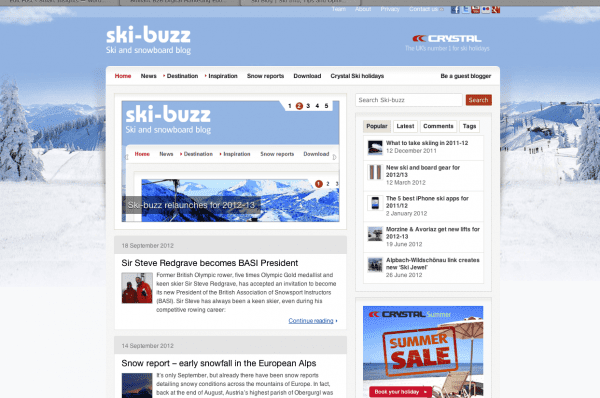A 5 step process for creating or refreshing a business blog
Whether launching a new WordPress blog or, as in my case, relaunching an existing blog, there are many issues to consider and a number of ways to approach the project.
Having recently redeveloped and redesigned a WordPress blog, to help other marketers, I thought I would share some of the considerations that we took into account. I've split the project up into two parts; this first post focuses on the objectives, planning and resource considerations. The more "hands-on" functionality and implementation considerations will follow in Part 2.
To add a bit of context, 3 years ago, a brand I now work on, set up a skiing blog called Ski-buzz, run on WordPress. Set up on a free theme and with minimal amounts of additional resource or budget it started life quite slowly. Unbranded, sitting on its own (totally separate domain) and growing slowly at first, it developed into one of the top skiing blogs in the UK. However, we needed a refresh...

The challenge
Whilst the blog was continuing to grow each year, there comes a point when bolting on plugins (additional bits of WordPress functionality) and making small changes isn't enough.
The challenge was therefore to redevelop and redesign the blog making sure the objectives were achieved and that, ultimately, it would be more successful (both as a blog and as a brand asset).
The 5 step process
Step 1. Know your objectives (and why they are your objectives)
The blog's objectives should be clearly mapped out well before any work actually starts. Perhaps more importantly, the objectives themselves should be scrutinized. Ski-buzz is part of a much larger social media and online content strategy and so the aims of the blog needed to feed in to the bigger picture.
Step 2. Start with questioning your audience
If you're launching a blog for the first time, start by asking questions to your intended audience. The more you can find out about what they're looking for, the better the end result is likely to be. This could be as simple as running a poll on Facebook (which we did).
If you're redeveloping a blog, consider running a pop-up poll on the existing blog several months prior to development (which we did). They are a number of good plugins that allow for easy implementation of pop up surveys. We used Qualaroo which has both free and paid accounts. Additionally, look at your blog's analytics (which we also did), identifying key paths and key content which need focusing on / making more of in the redevelopment.
Also think about what else the current blog does well?
A key consideration for us was that Ski-buzz, just like any other content marketing tool, is not a means to an end in itself. The blog was unbranded and, whilst it was referring traffic back to the target Ecommerce site, it wasn't making the most of this opportunity.
We also had to address the navigation, site performance (on page load factors & hosting) and SEO (more on each in part 2).
Step 3. Draw up a brief
It might be that your theme (whether free or premium) does it all and you don't require any development. On the other hand, you might want to introduce functionality that doesn't exist elsewhere, add or take away parts to a particular theme or alter the functionality of existing plugins. If any of these apply, I'd strongly suggest putting a brief together.
Detail what each different page type should look like structurally and how particular functionality should work. The brief I put together for the WordPress developer included a series of wireframes, written detail and, in some instances, links to other blogs or websites which demonstrated the functionality I was after.
Step 4. Make the developer(s) and designer your new best friend
Have a kick-off meeting with the developer (and designer) to ensure you're on the same page. Because our project involved quite a lot of additional development, the brief was broken down in to small sub tasks (if you have project management software such as JIRA this can make life really easy).
Even with a kick off meeting and detailed brief, there will inevitably be questions and unforeseen hurdles. During key periods of development you'll want to be in almost constant communication with your developer (I sat next to mine). Another useful part of the process is to run through each subtask once it's completed - ensuring nothing ever goes too far wrong without being picked up. This will save time in the long run.
Step 5. Set aside time for testing and evaluation
This is a really important step. It doesn't matter how well you think you've been through something, there will be things that get missed.
We had a small team of testers on hand, made up of people from different teams across the business. This meant they all had wildly different opinions and experience in using blogs. Some of the testers had never really used a blog before.
Rather than simply asking your testers to 'take a look at the blog', give your testers some tasks and get them to try every aspect of the site, from searching for content to using the navigation, following links, subscribing to email - anything and everything that means you'll have fresh eyes on each part of the blog. By providing structure and clearly defining what it is you're asking them to do, it will help avoid less helpful feedback such as personal opinion about design or choice of logo.
There are of course plenty of other considerations throughout a blog development project but the above has purely focused on the key steps in the process.
Part 2 will focus on some of the more hands on considerations such as SEO, hosting, design, tagging and categorisation.
If you have a question or have something to add to this post then please leave a comment below.







